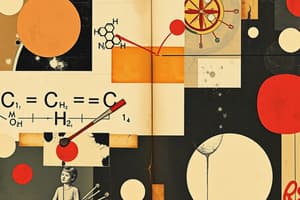Podcast
Questions and Answers
What information does a chemical equation contain?
What information does a chemical equation contain?
Chemical equations use chemical formulas and other symbols instead of words to summarize a reaction: Reactants (left side), an arrow (yields), products (right side), and coefficients.
What do the formulas, arrow, and plus signs in a chemical equation tell you?
What do the formulas, arrow, and plus signs in a chemical equation tell you?
The formulas tell you what elements are involved in the reaction, the plus signs separate the reactants/products, and the arrow means yields.
How are products and reactants different?
How are products and reactants different?
The reactants and products have very different properties from each other.
In your own words, state the meaning of the principle of conservation of mass.
In your own words, state the meaning of the principle of conservation of mass.
If the total mass of the products of a reaction is 250g, what was the total mass of the reactants?
If the total mass of the products of a reaction is 250g, what was the total mass of the reactants?
What must a balanced chemical equation show?
What must a balanced chemical equation show?
What prevents matter from entering or leaving a closed system?
What prevents matter from entering or leaving a closed system?
Can you measure all the reactants and products in a closed system?
Can you measure all the reactants and products in a closed system?
Can you measure all the reactants and products in an open system?
Can you measure all the reactants and products in an open system?
What are four categories of chemical reactions? Give an example of each.
What are four categories of chemical reactions? Give an example of each.
Study Notes
Chemical Equations
- Chemical equations summarize reactions using chemical formulas, symbols, and coefficients.
- Reactants are located on the left side, products on the right, separated by an arrow indicating "yields."
Components of Chemical Equations
- Formulas represent the elements involved in the reaction.
- Plus signs (+) denote individual reactants or products, while an arrow (→) indicates the progression from reactants to products.
Reactants vs. Products
- Reactants and products exhibit distinct properties, highlighting the transformation during a chemical reaction.
Principle of Conservation of Mass
- States that matter cannot be created or destroyed; total mass remains constant in chemical and physical changes.
Mass of Reactants
- If the total mass of products is 250g, then the mass of reactants must also be 250g, maintaining mass conservation.
Balanced Chemical Equations
- A balanced equation must reflect an equal number of each type of atom on both sides, ensuring mass conservation.
Closed Systems
- A container is required to prevent matter from entering or leaving a closed system, allowing for measurable analyses.
Measuring Reactants and Products
- All reactants and products can be measured in a closed system, whereas this is not possible in an open system due to potential matter loss.
Categories of Chemical Reactions
- Four main types of chemical reactions include:
- Synthesis: Combine elements to form compounds (e.g., 2Mg + 2O2 → 2MgO2).
- Decomposition: Break down compounds into simpler substances (e.g., 2MgO2 → 2Mg + 2O2).
- Single Replacement: One element replaces another in a compound (e.g., 2Cu2O + C → 4Cu + CO2).
- Double Replacement: Exchange of components between two compounds (e.g., FeS + 2HCl → FeCl2 + H2S).
Studying That Suits You
Use AI to generate personalized quizzes and flashcards to suit your learning preferences.
Description
Test your knowledge about chemical equations with this flashcard quiz. Learn how to interpret the components of chemical reactions, including reactants, products, and the symbols used. Perfect for reinforcing concepts covered in Chapter 6, Section 2.




